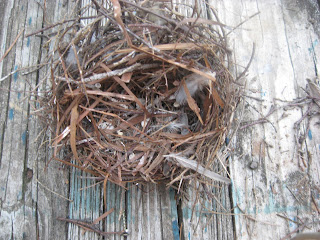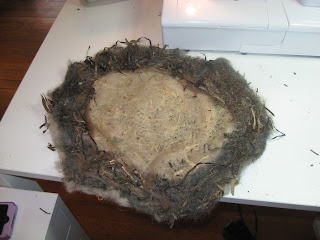Tender Beginnings: Thoughts on the Construction of Nests
Birds, tiny creatures with tiny brains, build their own homes. This fact raises in me profound feelings of respect and admiration, not only for birds' construction abilities, but also for the nests themselves, so perfectly designed for their purpose. As an art form, they are about as pure as they come--devoid of ego, arising only from need, and woven with skills passed down from the dawn of time.
I've just finished constructing a bird's nest with my felting machine, using natural materials like seaweed and raffia, and it was so time-consuming and labor-intensive that I wish I could have approached it with more of birds' instinct-driven cheerful urgency.
When I see an unused one on the ground, I usually snag it, and as a result, I've collected a few over the years. Once in a while, a family member gives me one or two. I'm going to show you a few.
This one, for example, sent to me by my brother-in-law, Deepak Mazumdar, is centered on a smoothly-constructed cup of mud, covered with soft fiber on the inside and rougher grasses and twigs on the outside. It's fragile but surprisingly durable. And how the heck to birds work with mud? Do they carry it up there in little buckets?
The next two reflect genius in the use of available materials. In the first one, the bird has clearly made use of at least one cigarette filter. In the bottom one, the bird has used what looks like shreds of a dirty plastic bag.
 |
| See the cigarette filter? |
 |
| Shreds of plastic bag? |
 | |||
| So maybe you can't tell, but this creation consists mainly of fishing line and dryer lint. |
In our yard, Joe and I have a house-shaped birdhouse on a post, and in that birdhouse there have lived many generations of house wrens, the adults of which are always tireless in the building and protection of their nest and the feeding of their babies. Their bubbly sound, both cheerful and nervous (you can hear it at this link--http://www.allaboutbirds.org/guide/house_wren/sounds) twittered forth about once every other minute. But if one of us was ever near their house, instead of twittering volubly, one parent bird would patrol the hemlock hedge next to the birdhouse, scolding and chattering and trying to get us to go away. I did explain that I was sharing my yard with it, and not vice versa, but it didn't help.
Last Sunday I found the birdhouse on the grass and the wrens gone. My theory is that a cat climbed into the hemlock and jumped over to the birdhouse. The house toppled to the ground and the cat ate its contents. This theory was confirmed when I saw a gray cat climbing in the hemlocks, and after neighbors told me that a new neighbor's cat was a mighty hunter.
I'm sorry the birds were gone, but I was anxious to see that nest into which they poured their all, week after week. I unscrewed the back of the birdhouse and found this:
Because I so admire nests and their creators, I recently used my new felting machine to make a nest out of seaweed, wool roving, water-retted flax, and raffia. This creation, Tender Beginnings, was made in response to an invitation extended to me and a few other American quilters to send entries to the Kagoshima Friendship Quilt Festival in Kagoshima, Japan. The theme of the show is My Favorite Season. Mine is spring, with its deliciously fulfilled expectancies. Thus, an image of a nest for the quilt festival.
Would you believe that I keep a bag of dried seaweed on hand, just in case? It's a natural material, super-lightweight and flexible, so I thought it would work well if I felted it onto a disc of wool batting.
The seaweed won't hold to the wool batting base unless it's held on with wool roving. Here's a look at that process, involving a layer of seaweed held down with wisps of roving. The needles of the felting machine felt the roving to the batting, holding the seaweed down.
When I was done, I had this:
So you know what I did? I flipped this creation over and sewed a piece of muslin to the back, outlining both the outer and inner edges of the nest. With the muslin thus sewn down, I was able to slit it in several places beneath the nest outline and insert fiberfill between it and the cloth, thus producing a three-dimensional effect. I sewed the result onto a sunprinted background that had been embellished with hand embroidery, applique, and felted leaves. I filled the nest with felted eggs.
And voila: Tender Beginnings.
It's an homage to birds and their homes.







.jpg)






